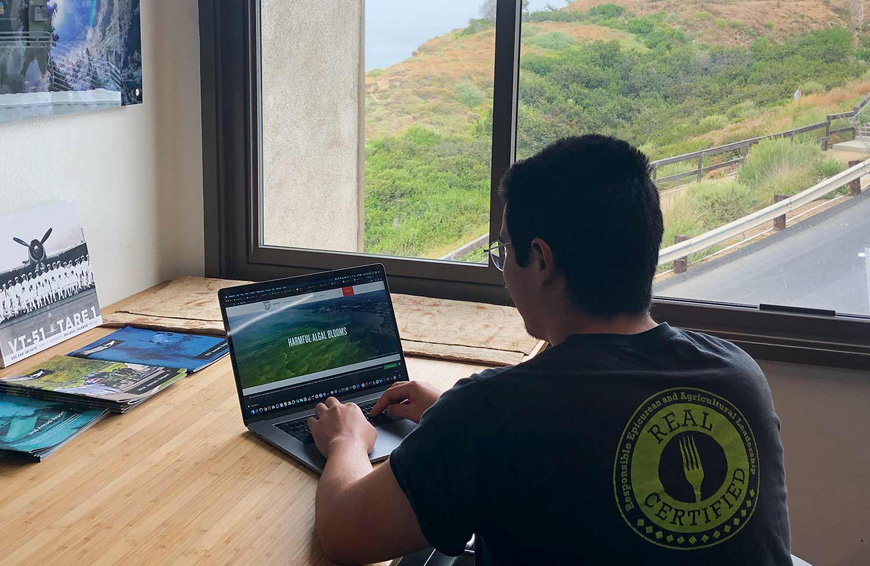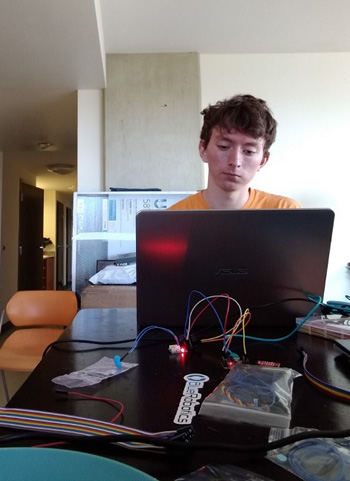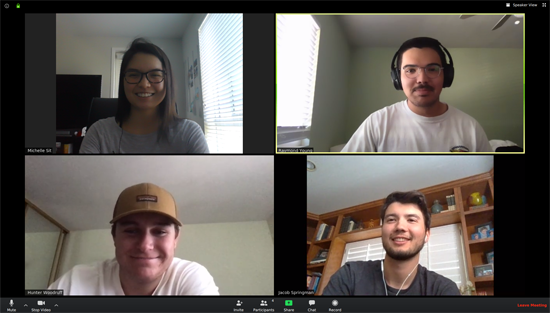| 正文(英文) |
 UC San Diego student Raymond Young works on Boeing-sponsored team project for the class Hacking for the Oceans.
A new course offering at UC San Diego is providing students with tools and training to tackle real-world problems facing the ocean environment. Launched in the spring of 2020, Hacking for the Oceans is a solutions-focused class led by marine scientists Eric Terrill and Sophia Merrifield at Scripps Institution of Oceanography and collaborator Steve Weinstein, a lecturer at UC Berkeley and Stanford.
In the course, of which the development was co-funded by the National Philanthropic Trust, interdisciplinary teams of students work closely with outside sponsors to develop rapid prototypes and innovative solutions to ocean-related challenges (think: ocean pollution, illegal fishing, real-time monitoring). Students are challenged to develop feasible solutions that are not only scientifically or technically possible but also have high potential to be adopted by end-users and a revenue-generating strategy.
Each team receives weekly guidance from their sponsor as well as an entrepreneurial mentor, further exposing students to the possibilities of a career outside academia. Sponsors range from local, state, and federal agencies to industry and non-governmental organizations.
“There’s certainly a gap between innovative research in academics and the translation of those ideas into products and services that are available to the public,” said Scripps scientist Merrifield, co-developer and instructor of Hacking for the Oceans. “The course focuses on ‘outside-of-the-classroom’ interviews to understand the demand signal for a solution before pivoting to technical development and deployment strategies, similar to what you would find in a startup.”
The oceans-oriented program is modeled after Hacking for Defense, a course that focuses on training students to address national security challenges. Initially launched at Stanford, Hacking for Defense has since expanded to more than 30 universities across the United States, including UC San Diego. It is a program of the National Security Innovation Network (NSIN), powered by BMNT Inc. and the Common Mission Project—BMNT's nonprofit arm which coordinates and facilitates entrepreneurship programs.
"I was thrilled to find kindred spirits at UC San Diego in Sophia and Eric who felt that it was important to create a new generation of entrepreneurs focused on the mission of ocean health,” said class instructor Weinstein, senior vice president of strategy at BMNT and a board member of the Common Mission Project. “Our mission at the Common Mission Project is to create an international network of entrepreneurs solving the tough problems. We felt that the oceans was an area that is underfunded and not a focal point for entrepreneurship, and figured teaming up with UC San Diego was the first step in creating a new network of mission-driven entrepreneurs.”
Students in both the hacking courses learn how to apply lean startup principles—a variation of the Lean LaunchPad methodology developed by Steve Blank, creator of the Lean Startup movement—to topical problems. This agile approach flips the standard business model on its head, calling for startups to rapidly experiment and gather feedback from potential customers before developing any further plans.
“The lean methodologies are designed to allow the students to apply the rigor of their science and engineering backgrounds to ocean-themed societal and technical challenges in an efficient manner,” said Scripps oceanographer Terrill, co-developer and instructor of the new course. “We hope that the students' experiences in communicating with their external sponsors and mentors, framing problems, and scoping solutions will carry with them as they leave the confines of academia. The outpouring of support from our sponsors and external mentors should cement for the students the value of their greatest asset—their education.”
While Hacking for the Oceans is led by Scripps, most of the 20 students are from other departments on campus, primarily the Jacobs School of Engineering. Enrollees include both undergraduate and graduate students, with areas of study including computer science and engineering, nanoengineering, electrical engineering, physical oceanography, and more.
This quarter, teams are working on the following projects:
-
Using radar and satellite data to detect routes in sea ice that can be used for safe polar navigation (Sponsor: Capella Space, Mentor: Gwen Nero, Scripps Oceanography);
-
Creating a software suite of autonomous unmanned surface vehicle (USV) behaviors for scientists and USV pilots to plan and execute their missions, including monitoring the environment for harmful algal blooms (Sponsor: Boeing, Mentor: Ellen Chang, BMNT);
-
Designing a cheap, durable flooding sensor and data acquisition system to provide critical alert information for vulnerable coastal communities (Sponsor: Center for Climate Change Impacts and Adaptation, Mentor: Rustom Jehangir, Blue Robotics);
-
Leveraging shortcomings in available data and technology to provide an insight into ‘potential fishy activity’—illegal, unreported, and unregulated fishing (Sponsor: NASA, Mentor: Chris Ward, Delawarde Consulting);
-
Designing a hardware attachment that effectively collects and analyzes in-situ water samples for micro-pollutants on location from different depths of the water column (Sponsor: AIIM Partners, Mentor: Paula Silvia, Port of San Diego).
Michelle Sit, a computer science and engineering master’s student, is on the team that’s developing a generalized autonomy software package for unmanned surface vehicles. The team is working to develop a user-friendly interface for scientists monitoring harmful algal blooms (HABs) by using the Liquid Robotics Wave Glider.
“Broadly, we are excited about how our framework can be used for other similar scenarios that involve patrolling an area and following a target of interest,” said Sit. “Some relevant audiences that come to mind are biological oceanographers, trash clean-up efforts, oil and gas companies, and the Navy.”
The interdisciplinary nature of this class was a major draw for Sit, who comes from a technical background. She started the course with no scientific knowledge about the ocean but said she’s already learned a great deal from the lectures and guest speakers.
“As an engineer, I find it fascinating to learn about what solutions interdisciplinary teams have come together and created to solve these problems,” said Sit. “I really appreciated conducting informational interviews to get a better sense of the current state of problems that scientists and engineers are looking to solve in this field. The teaching team and mentors have been phenomenal in providing great advice and feedback to guide us in the right direction.”
While in-person collaboration wasn’t possible this quarter due to the COVID-19 campus closure, the instructors tried to foster comments between groups with breakout rooms, feedback documents, and encouraging comments after presentations. The instructors hope to offer the Hacking for the Oceans class again next spring, and eventually, to expand it to other universities.
The current teams will be sharing their final projects on June 11 in a public presentation, giving sponsors and mentors a chance to see the culmination of 10 weeks of hard work, and the potential for future collaboration and innovation. Those interested in tuning in to the remote event can RSVP by visiting the event registration page.
– Brittany Hook
About Scripps OceanographyScripps Institution of Oceanography at the University of California San Diego, is one of the oldest, largest, and most important centers for global science research and education in the world. Now in its second century of discovery, the scientific scope of the institution has grown to include biological, physical, chemical, geological, geophysical, and atmospheric studies of the earth as a system. Hundreds of research programs covering a wide range of scientific areas are under way today on every continent and in every ocean. The institution has a staff of more than 1,400 and annual expenditures of approximately $195 million from federal, state, and private sources. Scripps operates oceanographic research vessels recognized worldwide for their outstanding capabilities. Equipped with innovative instruments for ocean exploration, these ships constitute mobile laboratories and observatories that serve students and researchers from institutions throughout the world. Birch Aquarium at Scripps serves as the interpretive center of the institution and showcases Scripps research and a diverse array of marine life through exhibits and programming for more than 430,000 visitors each year. Learn more at scripps.ucsd.edu and follow us at Facebook, Twitter, and Instagram. About UC San DiegoAt the University of California San Diego, we embrace a culture of exploration and experimentation. Established in 1960, UC San Diego has been shaped by exceptional scholars who aren’t afraid to look deeper, challenge expectations and redefine conventional wisdom. As one of the top 15 research universities in the world, we are driving innovation and change to advance society, propel economic growth and make our world a better place. Learn more at www.ucsd.edu.
|








修改评论